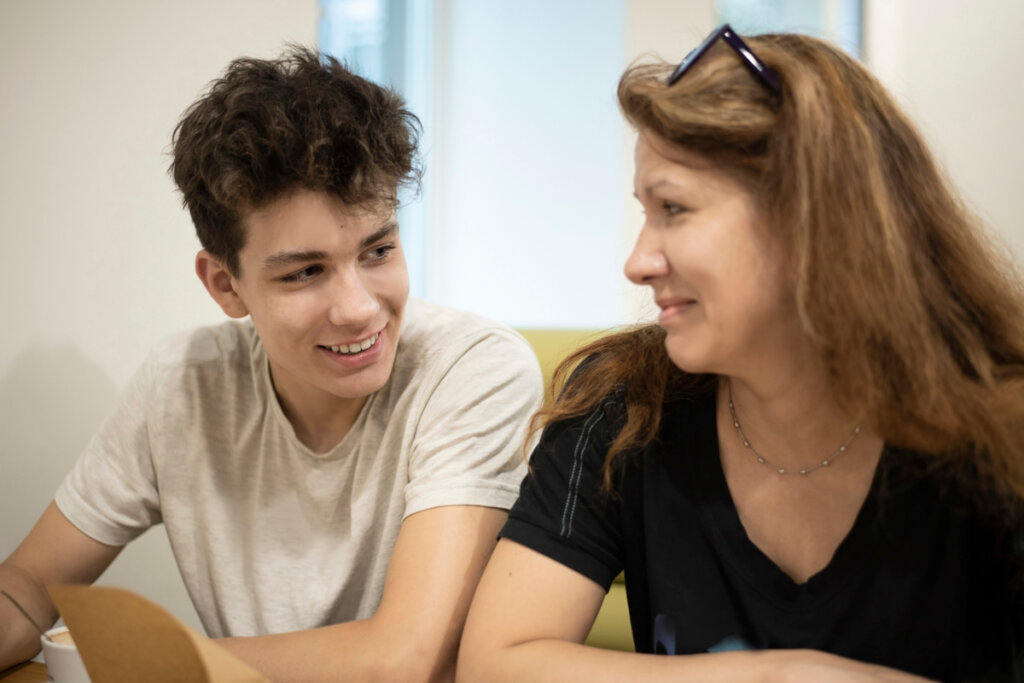How to Protect Your Children From Hopelessness


Written and verified by the psychologist Valeria Sabater
Protecting your children from hopelessness involves teaching them strategies to take care of their mental health. It means educating them from an early age in psychological strength and in the ability to face the frustrations, adversities, and disappointments of life. As a matter of fact, something as basic as this and, sadly, often neglected could produce great changes in the next generations.
As parents and educators, you focus on giving your children the best. For example, you initiate them, as soon as possible in the learning of languages. You give them the best schools, computers, and mobiles. You teach them to cross the road, instill a passion into them for reading, and tell them how to identify the North Star on summer nights.
However, you sometimes forget other important aspects within the educational framework. In fact, often, you don’t just neglect understanding and emotional management. You also overlook the importance of encouraging in them the ability to be excited and to move on when they feel discouraged and anxious.
You pass on, by education, protection against hopelessness in your children. Try, also, to be the best example you can for them. In addition, give them tools to deal with any daily discomfort. This will have a direct positive effect on their mental health.

How to protect your children against hopelessness
Today, functional sadness has been normalized. It’s the kind that doesn’t weigh heavily enough to prevent you from getting out of bed every day to leave the house, socialize, and fulfill your obligations. In fact, this kind of hopelessness is a common companion when you’re a teenager. It allows a sufficient degree of functionality so that others are unable to perceive it.
We understand hopelessness as an attributional style in which any event is negatively inferred. There’s no faith that what goes wrong today will improve tomorrow. It means interpreting certain things as inevitable, that nothing can be done to improve the situation. Hopelessness also means losing all vital meaning and having no purpose.
It isn’t difficult to work out that this mental focus is a direct factor of psychological vulnerability. In fact, it’s the same kind of vulnerability that builds depressive disorders and suicidal ideas.
It wasn’t until the 1990s that this dimension began to be studied in children and adolescents. Before then, a lack of hope was thought to be an adult thing, a study suggests.
Now, we have the Beck Hopelessness Scale (BHS) designed by Aaron T.Beck for the evaluation of this feeling. This scale suggests a rise in feelings of hopelessness among children and young people.
What can you do about it? The key is both simple and ambitious at the same time: protect your children against hopelessness. Let’s see how.
Being emotionally available parents in children’s lives
Parenthood isn’t only about being physically present in the lives of your children. It means knowing how to be available parents in every way, especially emotionally. Indeed, it’s essential to be a permanent presence in their lives to help them deal with disappointments, frustrations, fears, and anxieties.
Teaching them to manage what they feel, to normalize negative valence emotions without getting stuck in them is essential for the well-being of children.
Push them to have goals and purposes
Whenever you talk about goals and purposes, you tend to relate it to the lives of adults. However, nothing is as decisive in the daily lives of children and adolescents as having hope. Indeed, childhood must be nourished every day by feelings of hope, the ability to be amazed, and the discovery of new things on the horizon.
In the same way, adolescence doesn’t make sense if it isn’t tied to desires, goals, and short and long-term purposes. For this reason, you must motivate them and encourage them to set their own goals.
Teach them to solve problems on their own
When it comes to protecting your children against despair, there’s nothing better than giving them tools. In fact, you should guide them so that they learn to solve their day-to-day problems on their own. Indeed, it’s important that they gain autonomy and understand that they can achieve many goals by being independent. Furthermore, the satisfaction they gain from achieving autonomy improves their self-esteem.
Hopelessness feeds on negativity, lack of purpose, and low self-esteem. One way in which you can protect them from these adverse mental filters is by being close to them. It means guiding them to learn how to solve problems and thus gain self-efficacy and self-esteem.
Encourage less screen time and more life experiences
Nowadays, children become digital natives between the ages of three and nine. From then on, and during their preadolescence and adolescence, they no longer understand the world without screens.
Therefore, reducing their use and, above all, making it easier for them to have experiences outside of that digital world will allow them to improve their mental health. Signing up for sports or other practices is always beneficial.

Encourage them to have relationships with their peers
Children need to socialize, to build bonds with their peers. As far as possible, you should create opportunities for your children to meet other children their age. Try and facilitate mechanisms so that they always have friends with whom to laugh, play, talk, go on excursions, etc.
Promote resilience in them
Research works, such as those conducted by the University of Minnesota, highlight the importance of promoting in children what they define as “front line” resilience. In fact, it’s paramount that parents, educators, and health professionals lay the foundations of these competencies in their pupils so they’re able to face adversity.
In this way, if you want to protect your children against hopelessness, it’s crucial to teach them to tolerate uncertainty, frustration and have clear values. Adolescents win when they’re able to put their thoughts into practice that allows them to be more decisive and flexible.
Finally, in a time when young people are facing more and more mental health problems, let’s make some changes. Give them an education in hope.
Protecting your children from hopelessness involves teaching them strategies to take care of their mental health. It means educating them from an early age in psychological strength and in the ability to face the frustrations, adversities, and disappointments of life. As a matter of fact, something as basic as this and, sadly, often neglected could produce great changes in the next generations.
As parents and educators, you focus on giving your children the best. For example, you initiate them, as soon as possible in the learning of languages. You give them the best schools, computers, and mobiles. You teach them to cross the road, instill a passion into them for reading, and tell them how to identify the North Star on summer nights.
However, you sometimes forget other important aspects within the educational framework. In fact, often, you don’t just neglect understanding and emotional management. You also overlook the importance of encouraging in them the ability to be excited and to move on when they feel discouraged and anxious.
You pass on, by education, protection against hopelessness in your children. Try, also, to be the best example you can for them. In addition, give them tools to deal with any daily discomfort. This will have a direct positive effect on their mental health.

How to protect your children against hopelessness
Today, functional sadness has been normalized. It’s the kind that doesn’t weigh heavily enough to prevent you from getting out of bed every day to leave the house, socialize, and fulfill your obligations. In fact, this kind of hopelessness is a common companion when you’re a teenager. It allows a sufficient degree of functionality so that others are unable to perceive it.
We understand hopelessness as an attributional style in which any event is negatively inferred. There’s no faith that what goes wrong today will improve tomorrow. It means interpreting certain things as inevitable, that nothing can be done to improve the situation. Hopelessness also means losing all vital meaning and having no purpose.
It isn’t difficult to work out that this mental focus is a direct factor of psychological vulnerability. In fact, it’s the same kind of vulnerability that builds depressive disorders and suicidal ideas.
It wasn’t until the 1990s that this dimension began to be studied in children and adolescents. Before then, a lack of hope was thought to be an adult thing, a study suggests.
Now, we have the Beck Hopelessness Scale (BHS) designed by Aaron T.Beck for the evaluation of this feeling. This scale suggests a rise in feelings of hopelessness among children and young people.
What can you do about it? The key is both simple and ambitious at the same time: protect your children against hopelessness. Let’s see how.
Being emotionally available parents in children’s lives
Parenthood isn’t only about being physically present in the lives of your children. It means knowing how to be available parents in every way, especially emotionally. Indeed, it’s essential to be a permanent presence in their lives to help them deal with disappointments, frustrations, fears, and anxieties.
Teaching them to manage what they feel, to normalize negative valence emotions without getting stuck in them is essential for the well-being of children.
Push them to have goals and purposes
Whenever you talk about goals and purposes, you tend to relate it to the lives of adults. However, nothing is as decisive in the daily lives of children and adolescents as having hope. Indeed, childhood must be nourished every day by feelings of hope, the ability to be amazed, and the discovery of new things on the horizon.
In the same way, adolescence doesn’t make sense if it isn’t tied to desires, goals, and short and long-term purposes. For this reason, you must motivate them and encourage them to set their own goals.
Teach them to solve problems on their own
When it comes to protecting your children against despair, there’s nothing better than giving them tools. In fact, you should guide them so that they learn to solve their day-to-day problems on their own. Indeed, it’s important that they gain autonomy and understand that they can achieve many goals by being independent. Furthermore, the satisfaction they gain from achieving autonomy improves their self-esteem.
Hopelessness feeds on negativity, lack of purpose, and low self-esteem. One way in which you can protect them from these adverse mental filters is by being close to them. It means guiding them to learn how to solve problems and thus gain self-efficacy and self-esteem.
Encourage less screen time and more life experiences
Nowadays, children become digital natives between the ages of three and nine. From then on, and during their preadolescence and adolescence, they no longer understand the world without screens.
Therefore, reducing their use and, above all, making it easier for them to have experiences outside of that digital world will allow them to improve their mental health. Signing up for sports or other practices is always beneficial.

Encourage them to have relationships with their peers
Children need to socialize, to build bonds with their peers. As far as possible, you should create opportunities for your children to meet other children their age. Try and facilitate mechanisms so that they always have friends with whom to laugh, play, talk, go on excursions, etc.
Promote resilience in them
Research works, such as those conducted by the University of Minnesota, highlight the importance of promoting in children what they define as “front line” resilience. In fact, it’s paramount that parents, educators, and health professionals lay the foundations of these competencies in their pupils so they’re able to face adversity.
In this way, if you want to protect your children against hopelessness, it’s crucial to teach them to tolerate uncertainty, frustration and have clear values. Adolescents win when they’re able to put their thoughts into practice that allows them to be more decisive and flexible.
Finally, in a time when young people are facing more and more mental health problems, let’s make some changes. Give them an education in hope.
All cited sources were thoroughly reviewed by our team to ensure their quality, reliability, currency, and validity. The bibliography of this article was considered reliable and of academic or scientific accuracy.
- Kashani JH, Reid JC, Rosenberg TK. Levels of hopelessness in children and adolescents: a developmental perspective. J Consult Clin Psychol. 1989 Aug;57(4):496-9. doi: 10.1037//0022-006x.57.4.496. PMID: 2768609.
- Kashani JH, Dandoy AC, Reid JC. Hopelessness in children and adolescents. An overview. Acta Paedopsychiatr. 1992;55(1):33-9. PMID: 1310368.
- Lester D. Hopelessness in adolescents. J Affect Disord. 2015 Mar 1;173:221-5. doi: 10.1016/j.jad.2014.10.048. Epub 2014 Nov 15. PMID: 25462420.
- Lester D. Hopelessness in undergraduate students around the world: a review. J Affect Disord. 2013 Sep 25;150(3):1204-8. doi: 10.1016/j.jad.2013.04.055. Epub 2013 Jun 10. PMID: 23764384.
- Masten, A. S., & Barnes, A. J. (2018). Resilience in Children: Developmental Perspectives. Children (Basel, Switzerland), 5(7), 98. https://doi.org/10.3390/children5070098
This text is provided for informational purposes only and does not replace consultation with a professional. If in doubt, consult your specialist.







